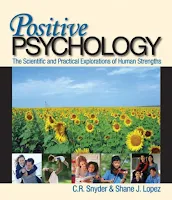POSITIVE
PSYCHOLOGY:
The scientific and
practical explorations
of human strengths
By
Reviewed by
"What is right
about people?" The authors welcome their readers with the ubiquitous
challenge of the positive psychology movement to consider what is right rather
than what is wrong with people (p. 3). The authors designed the book as a
textbook to provide a comprehensive overview of topics in the field. This is
the third collaboration of the two University of Kansas authors. Unfortunately,
it will be their last because senior author, C. R. (Rick) Snyder died January
17, 2006, a little more than a month after delivering the final draft of the
manuscript (xxv),
Readers will experience
an extensive tour of the expansive landscape of positive psychology with 19
chapters organized in 8 parts followed by 60 pages of references, along with
author and subject indexes. Part I contains chapters 1-4, which provide an
overview of positive psychology along with summary chapters on Eastern and
Western philosophical foundations for the field. As with any summary, the
knowledgeable reader will find the sweeping generalizations a bit too
simplistic. The three chapters of part Il reflect the authors' views about the
ways positive psychology may influence individual lifestyles and human
development, as well as the role of culture in determining what is positive. I
view parts Ill to V as the heart of positive psychology. These sections
represent the common cognitive-behavioral triad of en10tion (Part Ill, two
chapters about positive emotional states and experiences), cognition (Pan IV,
three chapters on topics such as self-efficacy, optimism, and hope), and
behavior (Part V, two chapters that examine positive interpersonal behaviors
such as gratitude, love, and flourishing).
Part VI contains ideas
for self-improvement and suggestions for prevention of mental health problems
as well as primary enhancement of physical and psychological health, Part Vll examines
the possibilities of positive influences in the common environments of school
(Chapter 16), work (Chapter 17), and the community (Chapter 18).
In Part VIll, the
authors organized an interesting agglomeration of visionary statements by
well-known positive psychologists (e.g., Ed Diener, David Myers, Shelley
Taylor). Of particular interest to JPC readers will be the comments by Kenneth
Pargament and Ev Worthington. Pargament appears to see a growing role for faith
and religion when he opines that "spirituality is what makes us uniquely
human" (p. 489). In addition, Worthington envisions the need to address
the impact of growing levels of stress disorders and problems such as violence
associated with projected increases in population primarily located in urban
environments. This section could have been enhanced if the authors had provided
either a synthesis of the opinions or an analysis suggesting the weight they
would assign given their perspective on the science. However, the blog-like
motif is interesting and certainly consistent with the current zeitgeist. The
entry by P. Alex Linley of the University of Leicester serves as a denouement assuming
the paradox of a successful failure of positive psychology. That is, if the
positive psychology movement succeeds, then psychology will balance both
positive and negative aspects of functioning and, thus, obviate the need for a
distinctive positive psychology.
Although the work was
designed as a textbook, readers who are clinicians will find the book useful on
several counts. First, the authors have produced a comprehensive introduction
to positive psychology, which is having a significant impact on research and
practice both in the academy and in industry and government. Second, the book
contains a number of activities and rating scales that could prove useful in
clinical practice. Third, readers who are asked to speak on various topics will
find the book a good starting point for an introductory talk, The stories and
exercises can be engaging, and the 59 pages of references provide solid leads
to additional information.
As a textbook, it is
most suitable for seniors or first year graduate students. The writing style
has some limitations. For example, the authors often write in a plodding,
passive style reminiscent of journal articles before 2000. Overall, the
limitations are mere quibbles because the book is a trove of information. I
would certainly recommend it to professors and clinicians alike.
Book Reference
Snyder, C. R. &
Lopez, S. (2007). Positive psychology: the scientific and practical
explorations of human strengths.
Thousand Oaks, CA: Sage.
Note, A newer edition is available See the Fourth Edition
A Related Book
Living well: 10 Big Ideas for a Meaningful Life
Connections
Please check out my website www.suttong.com
and see my books on
AMAZON or GOOGLE
STORE
Also,
consider connecting with me on
FACEBOOK Geoff W. Sutton
TWITTER @Geoff.W.Sutton
You can read many published articles at no charge—including this book review:
Academia Geoff W Sutton
ResearchGate Geoffrey
W Sutton

Comments
Post a Comment